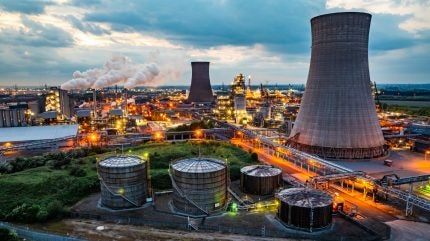
Carbon capture, utilisation and storage (CCUS) technologies that capture and store carbon dioxide (CO2) are among the tools that will likely need to be deployed if the world is to limit the rise in global average temperatures to 1.5°C above pre-industrial levels by the end of the century.
To achieve this target, not only does annual carbon dioxide (CO2) output need to reach net zero by the early 2050s, but the world may have to remove an additional 7-9 billion tonnes of accumulated CO2 per year from the atmosphere by mid-century.
However, heavy industries such as oil and gas, petrochemicals, iron, steel, and cement are considered hard to abate due to energy-intensive processes that cannot easily be replaced by electrification.
CCUS technologies can be employed to reduce emissions from these industries and also remove accumulated CO2 in the atmosphere.
What are CCUS technologies?
CCUS involves various methods to first extract CO2 from the air or the exhaust streams of power stations and industrial facilities and then permanently store it away underground.
These include chemical absorption of CO2 from industrial processes, pre- and post-combustion capture, and direct-air capture that uses air filters for extraction.
The captured CO2 is then stored in remote areas away from human habitation, such as underground salt caverns, depleted oil and gas reservoirs, and coal seams.
Utilisation refers to when the captured CO2 is employed for a range of industrial activities. These include enhanced oil recovery (EOR) – a process that can help reach more of a reservoir’s original oil deposits – providing feedstock for polymers, synthetic fuels and chemicals. According to the International Energy Agency (IEA), around 230Mt of CO2 is currently used each year, mainly for urea manufacturing in fertilisers and for EOR.
Are CCUS technologies important for net zero?
According to Power Technology’s parent company GlobalData, up to 25.4% of global annual emissions could be tackled with the applications of CCUS.
Clarice Brambilla, energy analyst at GlobalData, tells Power Technology: “Firstly, CCUS is currently the only man-made technology that can remove carbon from the atmosphere via direct air capture.”
“CCUS technologies play a crucial role in the global energy transition, as they are a great interim solution to help decarbonise hard-to-abate industries. For example, cement is the second most consumed product in the world, after potable water. Society still heavily relies on the cement industry, so a technology that can help reduce emissions from such a large, and high-emitting industry, is definitely an effective one.”
“100% electrification of the cement industry is currently not possible, due to a requirement for very high temperatures to heat limestone, for which fossil fuels are necessary. Therefore, the ability to capture the CO2 emissions produced at the source is currently the best option available.”
However, the sector is not expanding at the rate required to reach net-zero goals, the IEA says. It estimates that the total amount of CO2 that could be captured in 2030 will be around 435Mt per year. This is around 40% of the circa 1Gt CO2 per year that would need to be captured to hit net zero emissions by 2050, according to the IEA.
Dayanand Kharade, senior analyst for petrochemicals and new energies at GlobalData, tells Power Technology: “Recent technological advancements have enabled companies to capture well over 90% of the CO2 produced from the process streams. So, installing such units across emission-intensive facilities could go a long way in curbing the global carbon emissions.”
Where are CCUS technologies being used globally?
According to GlobalData’s 2023 Oil and Gas Sector Strategies in CCUS report, there were 66 active CCUS projects in 2023 and this number is forecast to rise to 285 by the end of the decade. GlobalData notes the main sectors exploring emissions reduction through CCUS technologies as oil and natural gas, coal, cement, chemical and petrochemical, iron and steel, shipping and aviation.
The US, UK, Canada, China, and Australia are the top five countries for CCS deployment, as per the Global CCS Institute’s 2023 report.
By 2030, the US is expected to lead the countries in CCUS capacity, with 171.6KT per year expected, while, in a bid to become the world’s first carbon-neutral industrial cluster by 2040, the UK’s Humber region is developing the Viking CCS cluster in the North Sea, among other CCS projects.
What are the challenges in deployment?
Firstly, CCUS technologies have a relatively high cost and also face low adoption currently. According to the IEA, while it can cost $100 to capture a tonne of carbon dioxide in iron and steel, direct air capture can cost up to $340 per tonne of CO2 captured in 2021.
Kharade comments: “Cost remains a key concern. In the past, some projects have also failed to meet their desired objectives due to reliability issues, profitability concerns, and other challenges. This has drawn criticism towards this approach.”
In fact, the Institute for Energy Economics and Financial Analysis said in 2022 that seven of the 13 flagship CCUS facilities responsible for 55% of operational capacity underperformed or failed.
In addition, one 2024 study found that implementing carbon capture could extend the oil production of one Canadian plant by 84 years, contrary to decarbonisation plans. CCUS processes are also energy intensive, and the technology requires significant transport and storage facilities.
Kharade says: “In most cases, the transportation of CO2 is undertaken through pipelines over long distances and traversing through numerous towns and cities. The potential threat of a leak in the pipeline due to extreme weather events, or an accident needs to be accounted for. A CO2 leak is deemed to have a worse impact than normal emissions due to the possible lingering of leaked CO2 around human settlements.”







